About Atosa-Nupuri
Mt. Iwo summit:508m
Mt. Iwo is also called “Atosa-Nupuri” meaning Atosa “naked” – Nupuri “mountain” in Ainu word. Shape of the mountain is lava dome and it is still active. It is not only splendid as scenery but also stores sulfur inside. There are a crater called “Kuma-otoshi” in the middle of the mountain erupted few hundred years ago and more than thousand fumaroles emitting volcanic gas. Because this gas includes sulfur content, area around Mt. Iwo smells sulfur. Yellow mineral around fumaroles is sulfer crystallized from sulfuric gas.
Mining sulfur
Meeting people and Mt Iwo starts when people hear that the Ainu people use sulfur as kindling. Mining started soon after Mt Iwo’s finding to use sulfer as match and gun powder in early 1870’s. Pioneering Eastern Hokkaido was accelerated by the mining at Mt Iwo and Kawayu became famous. Second Railway in Hokkaido was set in 1880’s, and sulfur was delivered. Later the demand of the sulfur declined, and mining was closed in 1963. Yet, Kawayu became more famous as Onsen Town where Sulfur Onsen from Mt. Iwo springs out. The source of the sulfur Onsen is very shallow less than 10m under the ground. pH of Onsen is about 2 which is very acidic and it is said that Onsen has some utilities.
Blessing of Mt. Iwo
Not only Sulfur Onsen but also the vegetation at the bottom of Mt. Iwo is very rare. Labrador tea tree is spread about 100ha and the community of the tree is said to be the beggest in Japan. As white flower of labrador tea tree is like a big carpet, you may gaze the scenery in the end of June. Labrador tea tree does not make a community in the lowland. As the gas from Mt. Iwo and acidic soil makes a hard effect to vegetation, only labrador tea which grows in harsh circumstance can grow. Stone pine tree, black crowberry and hanagoke grows in such a harsh land.
Photo Gallery
Access
Parking Fee
Motor BIke 200yen
Car 500yen
Micro Bus 1,000yen
Bus2,000yen
※Share ticket with Lake Mashu Viewpoint1.
※You can use ticket Parking of Mt.Iwo and Lake Mashu Viewpoint1 one each within 2days.
※Car which is longer than 5m is count as Micro bus.
※Parking is closed during Winter Season. You can park your car even when parking is closed, but we cannor take any responsibilities of stole and any other troubles.
Access(Airport, JR & Bus)
From Kawayu Eco-Museum Center
Kawayu Eco-Museum Center ⇒ Seasonal Eco Passport ⇒ Mt. Iwo
From Kushiro/Kushiro Airport
Kushiro Airport ⇒ Kushiro Airport Shuttle Bus(About 45min) ⇒ JR Kushiro station ⇒ JR Senmou Line(about 1hr 40min) ⇒ JR Kawayu Onsen Station ⇒ Seasonal Eco Passport(about 5min) ⇒ Mt.Iwo
From Abashiri/Memanbetsu Airport
Memanbetsu Airport ⇒ Memanbetsu Airport Shuttle Bus(about 30min) ⇒ JR Abashiri Station ⇒ JR Senmou Line(about 45min) ⇒ JR Shiretoko Shari Station ⇒ JR Senmou Line(about 45min) ⇒ JR Kawayu Onsen Station ⇒ Seasonal Eco Passport (about 5min) ⇒ Mt.Iwo
From Nakashibetsu Airport
Nakashibetsu Airport ⇒ Nakashibetsu Airport Shuttle Bus(about 30min) ⇒ Nakashibetsu Bus Terminal ⇒ Akan Bus(about 1hr 30min) ⇒ JR Shibecha Station ⇒ JR Senmou Line(about 30min) ⇒ JR Kawayu Onsen Station ⇒ Seasonal Eco Passport(about 5min) ⇒ Mt Iwo
Access(by car)
Mapcode
731 802 075*35
From Kushiro/Kushiro Airport
Kushiro city ⇒ 391 Line(about 2hrs 30min) ⇒ Kawayu Eco-Museum Center
Kushiro Airport ⇒ 53 Line(about 2hrs) ⇒ Kawayu Eco-Museum Center
From Abashiri/Memanbetsu Airport
Abasiri city ⇒ 244 Line・391 Line(about 1hr 30min) ⇒ Kawayu Eco-Museum Center
Memanbetsu Airport ⇒ 243 Line・52 Line(about 1hr 30min) ⇒ Kawayu Eco-Museum Center
From Nakashibetsu
Nakashibetsu Airport ⇒ 13 Line・243 Line・391 Line(about 1hr 30min) ⇒ Kawayu Eco-Museum Center




